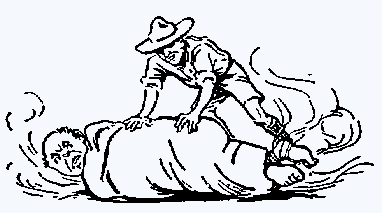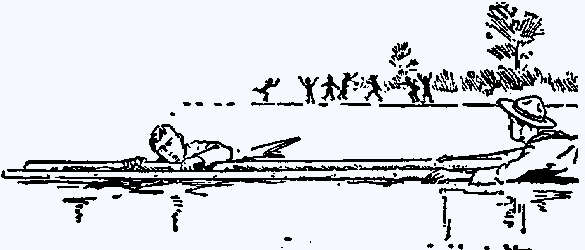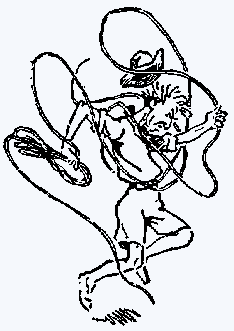Camp Fire Yarn No. 24
ACCIDENTS AND HOW TO DEAL WITH THEM
Panic • Fire • Drowning Runaway Horse • Miscellaneous
PANIC
Every year numbers of lives are lost by panics, which very often are due to the smallest
causes, and which might be stopped if only one or two men would keep their heads.
One evening some years ago, on board a ferry-boat in New York harbour, a man who had been
catching some crabs thought it would be a good joke to let one of them loose on board the boat. One crab caught hold of the
ship's cat and made it squeal, and it jumped into the middle of a crowd of schoolgirls, who at once scattered, screaming.
This started a panic among the hundreds of passengers on board. They rushed in every direction, and in a moment the railings
broke and eight people fell overboard. Before anything could be done they were swept away by the tide and drowned.
Some years back a man in a town in Russia, on opening his shop in the morning, saw a big
black bomb lying on the counter. He rushed out into the street to get away from it, and a policeman seeing him running mistook
him for a thief, and when he would not stop he fired at him. The bullet missed him, but hit another man; panic broke out and
many lives were lost. After it was over the man went back to his shop and found the bomb still on his counter-but it was not
a bomb, it was only a black watermelon!
Some years ago occurred a case of crush and panic among children in a theatre at Barnsley,
from no cause at all except overcrowding, and eight children were crushed to death. More lives would certainly have been lost
had not two men kept their heads and done the right thing. One man, named Gray, called to a number of the children in a cheery
voice to come another way, while the man who was working the show threw a picture on the screen and so diverted the attention
of the rest, and prevented a panic. If only one or two people keep their heads and do
the right thing on the spur of the moment, they can often calm hundreds of people, and thus save many lives.
When there is a panic among those around you, you may get a sudden desire to do as the
others are doing. Perhaps it is to run away, perhaps it is to stand still and cry "Oh!" Well, you should check yourself when
you have this feeling. Don't catch the panic, as you see others do-keep your head and think what is the right thing to do,
and do it at once.
RESCUE FROM FIRE
Instances of gallant rescues of people from burning houses are frequent. One sees them
every day in the newspapers. You should study each of these cases as they occur, and imagine to yourself what you would have
done under the circumstances. In this way you begin to learn how to deal with the different accidents.
An instance occurred some years ago where a young sailor, George Obeney, stationed at
Chatham in H.M.S. Andromeda, was walking along the Kingsland Road, when he suddenly saw a house on fire. A woman several storeys
up was screaming that she had some children there who could not get out. The sailor rushed from his friends and somehow scrambled
up the face of the wall till he reached the window below the woman, and broke in the glass so that he could obtain room to
stand. The woman at the window above was then able to lower a child so that he could catch it, and in turn pass it down to
the ground. Child after child was thus handed down till he had passed six of them to the ground, and finally two women. Then
the sailor, overcome by smoke himself, fell insensible, but was caught by the people below. His was an example to you of how
to do your duty AT ONCE, without thinking of dangers or difficulties.
A few years ago a house caught fire at Shoreham Beach, and the local Boy Scout Troop was
quickly on the scene. They did their work as true Scouts, not only in acting as firemen and getting the fire under control,
but also as life-savers in rescuing two ladies and a child, and then in rendering first aid to them and dressing their injuries.
HOUSE ON FIRE!
If you discover a house on fire you should-
1st-Alarm the people inside.
2nd-Warn the nearest policeman or fire station.
3rd-Rouse neighbours to bring ladders, mattresses, carpets, to catch people jumping.
After the arrival of the fire engines the best thing boys can do is to help the police
in keeping back the crowd out of the way of the firemen.
If it is necessary to go into a house to search for feeble or insensible people, the thing
is to place a wet handkerchief or cloth over your nose and mouth and walk in a stooping position, or crawl along on your hands
and knees quite near the floor, as it is here that there is least smoke or gas. Also, for passing through fire and sparks,
get hold of a blanket, if you can, and wet it, and cut a hole in the middle through which to put your head; it forms a kind
of spark-proof mantle with which you can push through flames and sparks.

When a fire occurs anywhere near, Scouts should assemble their Patrols as quickly as possible
and go off at Scout's Pace guided by the glare or the smoke. Then the Patrol Leader should report to the police or firemen,
and offer the help of his Patrol either to form a line to keep the crowd back, or to run messages, or guard property, or to
help in any way.
If you find a person with his clothes on fire, you should throw him flat on the floor,
because flames only burn upwards, then roll him up in a rug or carpet, coat or blanket. Take care in doing so that you don't
catch fire yourself. The reason for doing this is that fire cannot continue to burn where it has no air.
When you find an insensible person (in his fright he may have hidden himself under a bed
or table), you should either carry him out on your shoulder, or, what is often more practicable in the case of heavy smoke
or gas fumes, harness yourself on to him with sheets or cords and drag him out of the room along the floor, crawling on all
fours yourself.
To do this you make a bowline at each end of your rope; one you put over the patient's
chest and under his arms, and the other over your own neck. Then with your back to his head you start on all fours to pull
him along head first. If the bowline is the right length it will keep his head up off the ground, as the picture on page 258
shows.
RESCUE FROM DROWNING
The list of Boy Scout heroes shows you what a large proportion of accidents are due to
not knowing how to swim. It is therefore, most important that everybody should learn to swim, and, having done so, to learn
how to save others from drowning.
A great Channel swimmer, writing in "The Boys' Own Paper", pointed out that a boy, when
learning to swim, should learn first how to get in and out of a boat, i.e., by climbing in over the stern. Secondly, how to
support himself on an oar or plank, i.e., by riding astride on it, or by catching hold of one end, and pushing it before him
and swimming with his legs. Thirdly, how to get into a floating lifebuoy, i.e., by shoving the nearest side of it down under
water and capsizing it over his head and shoulders, so that he is inside it when it floats. Fourthly, how to save life.
A moderate swimmer can save a drowning man if he knows how, and has practised it a few
times with his friends.
The popular idea that a drowning person rises three times before he finally sinks is all
nonsense. He may drown at once, unless someone is quick to help him.
The important point is not to let the drowning person catch hold of you when you get to
him, or he may drown you too. Keep behind him always.
Put an arm across his chest and your hand under his armpit, telling him to keep quiet
and not to struggle. If he obeys, you can easily keep him afloat. But otherwise be careful that in his terror he does not
turn over and catch hold of you. If he should seize you by the neck place your arm round his waist, and the other hand, palm
upwards, under his chin, with your finger-tips under his nose. Pull and push, and he must let go. If you find yourself clutched
by the wrist, turn your wrist against his thumb and force yourself free. But you will never remember this unless you practise
it frequently with other boys first, each taking turns in being the drowning man or the rescuer.
Any of you who cannot swim as yet, and who fall into the water out of your depth, remember
that you need not sink if you take care to do the following things. First, keep your mouth upwards by throwing the head well
back. Secondly, keep your lungs full of air by taking in long breaths, but breathe out very little. Thirdly, keep your arms
under water. To do this you should not begin to shout, which will only empty your lungs, and you should not throw your arms
about or beckon for help, because this will make you sink.
If you see a person fall into the water and begin to drown, and you yourself are unable
to swim, throw a rope, or an oar or plank right to him, so that he may clutch at it and hold it. If a person falls through
ice, and is unable to get out again because of the edges breaking, throw him a rope and tell him not to struggle. This may
give him confidence until you can get a long ladder or pole across the hole, which will enable him to crawl out, or will allow
you to crawl out to catch hold of him.

THROWING A LIFELINE
It is often much more use to be able to throw a rope within the reach of a drowning person
than to jump in after him and make two to be pulled out.
A good length for a throwing or heaving line is 7 fathoms (42 feet). If you are making
up a special throwing line, it should be of nice pliable braided or stranded rope about | in. in diameter. For long throws
it's usually the practice to make a heavy knot in the throwing end.
Now decide which hand is going to do the throwing. Most people naturally use their right.
On that hand coil up your throwing line very carefully, clockwise, making the coils, say, 18 ins. from top to bottom. When
about half is coiled on, turn up a finger to separate those coils and coil the rest on to the remaining ringers of your hand.

When you come to the end of the rope, hold it firmly in your left hand with the last three
fingers, or, better, have a loop in the end that will fit down over your wrist so you don't lose the end in throwing. Then
pass back the second set of coils from your right to the first two fingers of your left hand. Now you have a coil in each
hand.
The right-hand coil is the one you throw first, and you follow it instantly with the left
coil, not letting go of the end. Thrown out like this, the line won't tangle up, and it's possible to throw the whole line
out straight, so that it will reach the farthest. Sending it out in one coil nearly always results in the coil not opening
properly, and a short reach in consequence.
Throwing can be underhand or overhand. The latter is better exercise and almost essential
if the line has to be thrown from behind an obstruction, such as a bulwark or wall, or has to be thrown to people in an upper
storey in case of fire.
RESCUE FROM RUNAWAY HORSES
Accidents sometimes occur from runaway horses running down people. It is well that everybody
should know how to stop a runaway horse, and thus to prevent injuries.
The way to stop a runaway horse is not to run out in front of it and wave your arms, as
so many people do. Instead race alongside it, catch hold of the shaft to keep yourself from falling, seize the reins with
the other hand and drag the horse's head round towards you, turning the horse until you can bring it up against a wall or
house, or otherwise compel it to stop. But, of course, for a boy, with his light weight, this is a very difficult thing to
do. The share he would have in such an accident would probably be to look after the people injured by the runaway horse.
MISCELLANEOUS ACCIDENTS
One cannot go through the whole list of accidents that might come to your notice, but
the point is that a Scout should always remember to keep his head, and think what is the right thing to do at the moment,
and be the man to do it, even under the most unexpected circumstances.
Scout J. C. Davel, 1 st Bloemfontein Troop (South Africa), saw a little girl entangled
in some electric-light wires on the roof of a house. Although he was warned not to go to her, as he might be killed too, he
climbed up and got her down. Unfortunately, the child was dead.
Scout Lockley, 1st Atherstone Troop, was at a fair looking on at a roundabout (merry-go-round)
which was being worked by electricity from a steam engine. The driver of the engine in leaning over got his clothes caught
in the machinery, and was being dragged into it when Lockley sprang on to the engine, and, knowing something of mechanics,
pulled over the lever, and stopped it just in time to save the man's life.
There is an example of a fellow Being Prepared, knowing what to do, and doing it without
a moment's waiting.
PATROL PRACTICES IN LIFE SAVING
Practise forming a "fence" with staffs, for keeping back a crowd. This can be made a game
by dividing the Troop into "crowd" and "Scouts".
Instruct Scouts to know the position of fire plugs and hydrants, police points, fire alarms,
fire stations, ambulances, hospitals, etc., in the neighbourhood.
Practise tying bowlines in rope and dragging an insensible person.
Do everything possible to get Scouts taught how to swim. In a town with a swimming bath
this should offer no difficulty. In the country, the best chance for Scouts to learn swimming is by arranging summer camp
near the sea or a lake or river where it is safe to swim.
Practise the various methods of rescue of a drowning person.
GAMES IN FIRE RESCUE
Prepare a heavy smoke fire in a neighbouring room or building, while you are in the club
room. Secretly arrange with two or three boys that if an alarm of fire is given they should run about frightened and try to
start a panic.
Have the alarm given either by getting someone to rush in and tell you of the fire, or
by having some noisy fireworks fired. Then let a Patrol or two Patrols tackle the fire under the direction of their Patrol
Leaders. They should shut windows and doors, and send Scouts into different parts of the building to see if the fire is spreading,
and to search for people in need of rescue.
These Scouts should have wet handkerchiefs over their mouths and noses. "Insensible" people
(or sack dummies) should be hidden under tables, etc. Scouts rescue them by shouldering them or dragging them out and getting
them down to the ground. Use jumping sheet, chute, etc.
Other parties make lines for passing fire buckets.
Another party revive the rescued. Another party form a "fence" to help the police and
fire brigade by keeping the crowd back.

